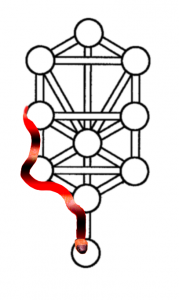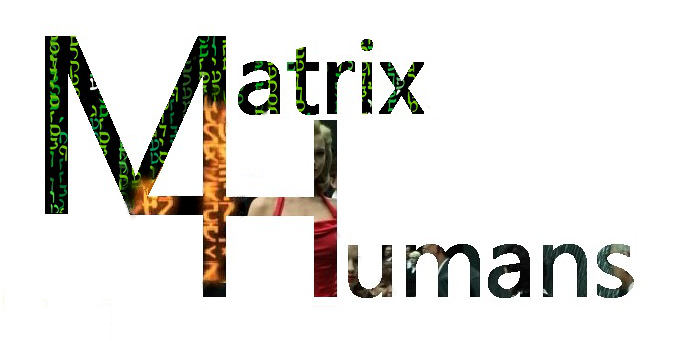A Snake By Any Other Name
Kabbalah groups almost everything we would call ‘evil’ under the heading of the “Sitra Achra,” which means the “other side.” This includes entities such as the serpent in the Garden of Eden story, the ‘satan’ (accuser), the celestial ‘dragon,’ certain angelic beings, and even our own “evil inclination.”
For instance, in the New Testament book of ‘Revelation’ (a very kabbalistic text), we find this grouping:
He laid hold of the dragon, that serpent of old, who is the devil and the satan, and bound him for a thousand years.
Revelation 20:2
The Zohar connects the serpent with the satan/accusing angel:
AND THE SERPENT. R. Isaac said: This is the evil tempter. R. Judah said that it means literally a serpent. They consulted R. Simeon, and he said to them: Both are correct. It was Samael, and he appeared on a serpent, for the ideal form of the serpent is the Satan.
Zohar 1:35b
In all cases, nothing is seen as being a separate force with its own goals, ‘fighting’ in opposition to the Creator. Rather, “there is only One power,” (“Ein Od Milvado”) and everything serves the will of the Creator. The negative forces of the Sitra Achra were created for the same ultimate purpose – to bring everything to a state of repair and unity.
Our present existence is one full of ‘opposites’ that need to be resolved. (See “Matrix Resurrections: From Binary to Unified”).
 This includes the sefirot themselves, which have ‘opposing’ right and left attributes. (See also the idea of Trinity ‘opposing’ Neo as the ezer kenegdow, in our article on Trinity’s kiss.)
This includes the sefirot themselves, which have ‘opposing’ right and left attributes. (See also the idea of Trinity ‘opposing’ Neo as the ezer kenegdow, in our article on Trinity’s kiss.)
As the left side of the tree is that of ‘constriction’ (tsimtsum) it is said that ‘evil’ emanates from that region, as it ‘restricts’ the light of truth. As we’ve mentioned, this does not make the emanations on that side ‘bad.’ Without the left side and tsimtsum, we could not find our way “back to the Source,” as the same force restricts the concealment we live in, enabling us to see the truth.
In fact, it is the left-side attributes that create the balance needed for things to function:
The mystic power of the left … dispenses good and evil, thereby rendering the world habitable.
Zohar 1:18a
Thus, there are no “bad guys” in the Matrix story. At least not at the higher level of understanding. The “cat we’ve let out of the bag,” is that Matrix is itself the means for humanity to get its act together. (See Consciousness Barriers in the Matrix.)
Things are not always as they appear when dealing with forces beyond our limited understanding:
Tamar Frankiel, “The Gift of Kabbalah”
It’s interesting how the above quote mentions “billiard-ball causation” as being a faulty view. As we showed in our character profile on the Merovingian, this reflects his limited understanding of reality.
One Very Old Serpent
We’ve discussed Agent Smith as being an aspect of Gevurah (judgment), which reflects the concept of ‘hasatan’ – the satan – which means the ‘accuser.’ Smith was virulent in his statements about human beings, comparing them to a virus. Of course, much of what he said had truth in it – and according to the back story, was what got the humans into trouble (and into the Matrix) in the first place.
In our article on evil and imperfection, we mentioned that evil can be either annihilated and reabsorbed, or it can be transformed back into good. Smith seems to have experienced the first of these. But what awaits the Merovingian in The Matrix Resurrections?
Since 2003. fans have been asking, “What happened to the Merovingian at the end Matrix Revolutions? Was he too ‘taken over’ by Smith? Or did the “trafficker of information” avoid this? Perhaps he even expected it, as he liked to boast.
And why are we equating him with the Biblical figure of the serpent?
The two most basic elements were given to us in Matrix Reloaded:
Oracle: “… a very dangerous program, one of the oldest of us.”
Persephone: “He was so different. He was like you.”
What Persephone states is no longer the case of course. In a manner different than Smith, the Merovingian also became an ‘opposite’ to Neo. Whereas Smith was created that way and functioned ‘upon’ the Matrix’s inhabitants, the Merovingian began with the potential to do good (he was “like Neo once”) and has a more intimate relationship with humans (including all his “club members.”)
His doctrine of ‘causality’ leaves no room to feel grateful for anything.
Turning good into bad is the power of the Snake. The idea of ingratitude is linked to the Snake. The Snake was originally created with an erect posture and with speech. Instead of being grateful for these gifts, and using them for the good, the Snake nurtured jealousy of Adam and tried to seduce Adam and Eve to sin. This is, which is “repaying good with evil.”
“Falling, Getting Up, Snake & Moshiach,” Dovber Pinson
A third element is one that has been well recognized (though not as we present it), and that is Neo as a “messiah figure,” and how this relates to the Merovingian in both of the above quotes.
This is where it gets interesting. In kabbalah, there is a connection between the concept of the messiah and the serpent — the ‘nachash’ (nah-hahsh).
The following reflect on the above elements:
- Both are seen as ancient entities. The serpent/nachash appears suddenly in Genesis chapter 3 and the role/function of the messiah is said to preexist the world.
- Both have the ability to ‘benefit’ humankind. It is taught that the initial purpose of the serpent was to be of assistance, but pride got in the way. (See the Merovingian profile.)
- Both have an interest in the ‘divine presence’ – the Shekinah, the “bride/daughter” personae. (See “The Matrix Resurrections: Irreconcilable Differences”).
- The gematria (numerical value) of both ‘messiah’ and ‘nachash’ is 358.
The Divining Serpent
As we discussed in our article on the Train Station, the Merovingian had a desire for ‘divination’ (predicting the future) through what he called “the eyes of the Oracle.”
There is another interesting connection here. The unsavory Biblical character of Balaam was known for his divination skills. There is a text related to him that sheds some additional light on our present topic:
“… he did not resort to divination as on previous occasions, but he turned his face toward the wilderness.”
Numbers 24:1
What is fascinating here is that the word for ‘divination’ in this verse is n’hashim, which is the plural of nachash. The same term is used for both. So we have a direct connection between serpent (the Merovingian) and divination – the ability that the Merovingian hopes to acquire.
A Poisonous Charisma
As discussed in previous articles, the characters in the movies represent different emanations that are present within every human. Thus, with regard to the Merovingian, it’s not only about all the things we see in him. He appeals to the same characteristics within others.
The Merovingian is absorbed in his own self-gain. He “traffics information” and makes ‘deals,’ to supplement his hedonistic lifestyle. Some are drawn to his self-centeredness, as he promises others things for themselves, centered around materialism.
As is said, “birds of a feather flock together.”
The danger of being drawn in by the seductive deception of the serpent are quite ancient:
Rabbi Ariel Bar Tzadok
Kabbalistically, this attraction is associated with the serpent and his effect upon humans – one that drives the latter further into the Matrix world of concealment:
The main attack of the snake/evil inclination is to put the soul asleep to Divine connection. He injects the poison of materialism and causes the soul to forget what it is here for.
“Nadab & Abihu: Gate of Reincarnations: Ch. 33,” Shabtai Teicher
The serpent in the Genesis story offered an ego-driven fantasy, as does the Merovingian. Keep in mind how the latter spoke to people (with both illustrious as well as demeaning language) as you read this comment:
What is the Nachash? The Torah describes him as ‘Arum’ (Genesis 3:1). Literally, the word Arum means ‘sly’, in the sense of manipulative and sneaky. But what does the Nachash symbolize for us? … the Nachash is fantasy and false imagination. The snake had an over-active imagination and was trapped in a world of fantasy. … Our own overactive imagination and fantasy, our inner snake, clouds and distorts our accurate vision of reality. This ego-based faculty ends up feeding us only what our ego wants, or, in a distorted way, what our ego is afraid of. Our fantasy either paints us as all-powerful and important or as utterly worthless and destitute. If your ego is focussing on money, for example, it may create imagery of you becoming a billionaire, or of you losing your job and living on the street. This is the danger of the ‘snake’; it pulls a person out of a perception of reality and inflates his ego with exaggerated grandiosity or crippling fear.
“Falling, Getting Up, Snake & Moshiach,” Dovber Pinson
No one has to give in to any ‘predispositions’ they may have. What we direct ourselves towards, will be there to find us. This will be especially true of the people in The Matrix Resurrections.
As Neo said, “The problem is choice.”
We here learn the mystical lesson that all species of witchcraft are linked up with, and proceed from, the primeval serpent who is the foul and unclean spirit. Hence all sorceries are called n’hashim (serpents). And whoever becomes addicted to them pollutes himself, nay more, he has first to become polluted in order to attract to himself the side of the unclean spirit. For it is a dictum of our teachers that corresponding to the impulses of a man here are the influences which he attracts to himself from above. Should his impulse be towards holiness, he attracts to himself holiness from on high and so he becomes holy; but if his tendency is towards the side of impurity, he draws down towards himself the unclean spirit and so becomes polluted.
Zohar 1:125b
Conversely, one of the main attributes of Neo that some find appealing is that of his humility and selflessness (bittul). The latter is connected to his willingness to put his own life on the line for the sake of others, as he did in all three movies.
Transformation of the Serpent
There remains a “fight on the ground” however:
The battle between good and evil first takes place in the upper realms and then the lower realms.
“Secrets of the Redemption,” Moshe Chaim Luzzatto, 1707-1746
The ‘result’ of this final struggle relates to what was mentioned earlier regarding one of two ways that evil is dealt with – in this case, ‘transformation’ back into the good:
A step deeper, Mashiach comes to transform, sublimate, and harness the snake energy to the good side.
“Nadab & Abihu: Gate of Reincarnations: Ch. 33,” Shabtai Teicher
In an “ultimate turnabout,” the arrogant serpent is humbled into service:
As soon as the kingdom of the Mashiach will be established, the remarkable feature will be that his former enemies will make peace with him … Even the erstwhile “Nachash” [the proverbial “Snake”] will be turned into “Choshen” [breastplate of the High Priest, spelled with the same letters as “Nachash”].
“King With a Purpose,” Chabad.org
Just as the Merovingian was “once like Neo” (per Persephone), he had a close connection to the Source and a mission to fulfill. As we see in the glimpse of his lifestyle, he is all about selfish desires and acquisitions. He preys upon the same defect in humans, bringing them into his false world, further concealing the truth from them.
How will this relate to the humans in The Matrix Resurrections?
There is a part of us that is beyond the ego, beyond snake consciousness, beyond fantasies, and essentially beyond physicality itself. It is that part of us which is always whole, perfect and unified.
Dovber Pinson
The conclusion of the Matrix story will involve not only a greater action on the part of Neo – it must include an awareness of “the Neo” within, on the part of each person who sets their mind on ‘return.’
“You saved me.”
Neo: “You saved yourself.”
We will expand on this and related subjects in future articles on The Matrix: Resurrections. This is just the tail end of the snake!



